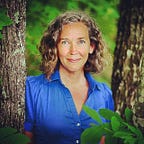What 410ppm means for the U.S. climate movement in one word
On April 20th, a week or so before the People’s Climate March, the Mauna Loa Observatory recorded for the first time, that the concentration of carbon dioxide in the atmosphere breached 410 parts per million. The last time the concentration of carbon in the atmosphere was at this level, humans did not exist. And it’s important to recognize that carbon dioxide can stick around in the atmosphere for thousands of years.
Leading climate scientists have determined that the safe threshold of carbon in the atmosphere for humans is 350 ppm. In fact, Bill McKibben and 350.org built a whole movement around this number.
While essential, even drastic reductions in fossil fuel emissions will not be enough to get us back to 350ppm within the timeframe necessary to avoid catastrophe. That’s why in addition to rapidly transitioning away from fossil fuels to clean energy such as solar and wind, we must also suck more carbon out of the atmosphere. The only way we can do that is through a massive scale up in the protection of forests. So, in one word what does 410 ppm mean to the U.S. climate movement? Forests.
Not only are standing forests the most highly evolved, complex, efficient and proven technology available for removing vast amounts of carbon from the atmosphere, but they also play a vital role in protecting us from extreme weather events. Standing forests provide natural flood control, help to stabilize fresh water supplies and otherwise have a cooling effect on the local climate. We simply must start leaving way more of the Earth’s forests standing all across the globe, including in our own backyard.
Yet, the US is the world’s largest producer and consumer of wood products and the rate of logging in the Southern US alone is four times that of South American rainforests. It’s critical that we elevate forest protection as a national climate priority. That’s the reason I recently co-authored a report entitled: The Great America Stand: US Forests and the Climate Emergency with renowned climate scientist Dr. Bill Moomaw.
A broader message that includes forests will not only help to further expand and diversify the climate movement (people love forests!) but also build solidarity with those working on the frontlines of forest destruction in the US where logging rates are among the highest on Earth. Many frontline communities in the rural, coastal South are not only directly impacted from pollution from power plants and pipeline projects but also are also bearing the brunt of the impacts of forest destruction and toxic pollution from industrial mills that manufacture wood products, such as paper. These are the same communities that are most at risk from the impacts of extreme weather events and need standing forests to provide a safety net against flooding and droughts.
Many of these same rural communities in the South are now having to fight back an onslaught of new plants that will destroy even more coastal forests and create more air pollution to make wood pellets to burn in power stations as an alternative to fossil fuels for generating electricity. Most of the wood pellet facilities today are exporting to Europe where laws treat burning wood in place of coal as climate friendly even though it releases up to 50% more carbon in the atmosphere than coal and relies on the large scale logging of the very forests we need to protect. In the U.S. a spending bill just passed the House with a provision that would treat the burning of trees for energy as having zero carbon emissions. These recent developments underscore the need to expand and amplify the message that protecting forests is a climate priority.
Frontline community groups and forest protection groups in the South are now working in solidarity to stop new wood pellet mills from being constructed and to scale up the protection of wetland forests along rivers to protect our most vulnerable against extreme flooding events. For example, the Concerned Citizens of Richmond County and Dogwood Alliance, with the support of nationally renowned climate justice organizer Reverend Leo Woodberry, have joined forces to stop the world’s largest wood pellet manufacturer, Enviva, from building a new wood pellet mill in North Carolina. This same community is already suffering from air pollution from a nearby Duke Energy plant and is also targeted for the newly proposed Atlantic natural gas pipeline.
I was inspired by communities on the frontlines of climate change taking a visible leadership role in the People’s Climate March in DC. Native American tribes, African Americans, immigrants and other traditionally marginalized communities led the march. It was an honor to be invited to march with Reverend Woodberry, The Concerned Citizens of Richmond County and other frontline community groups. As the carbon in the atmosphere breached 410 ppm, it’s reassuring that forests are beginning to make it to forefront of the US climate movement. It’s the communities on the front-lines that are helping to make that happen. And that’s how we will win on climate in the U.S.
